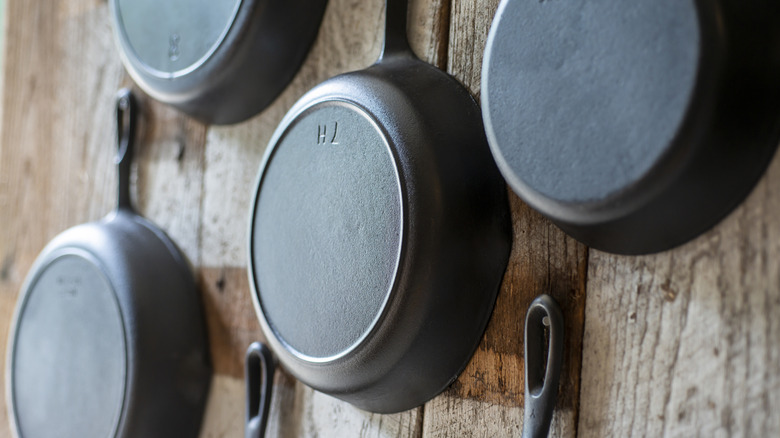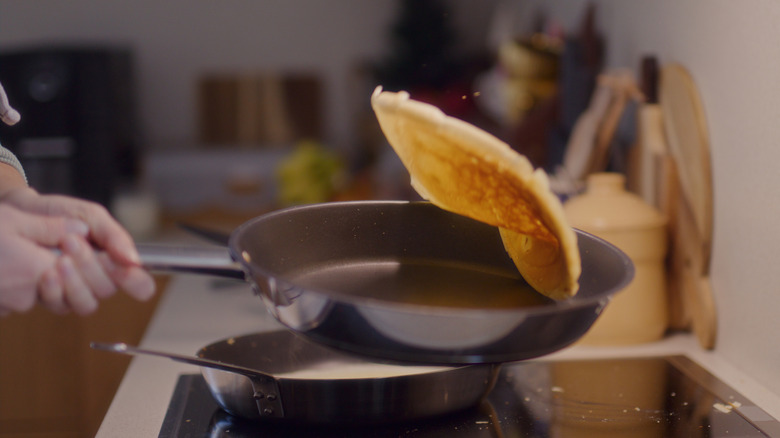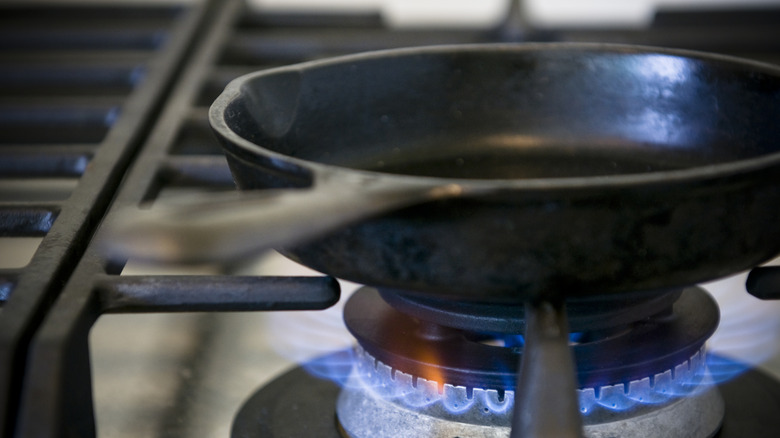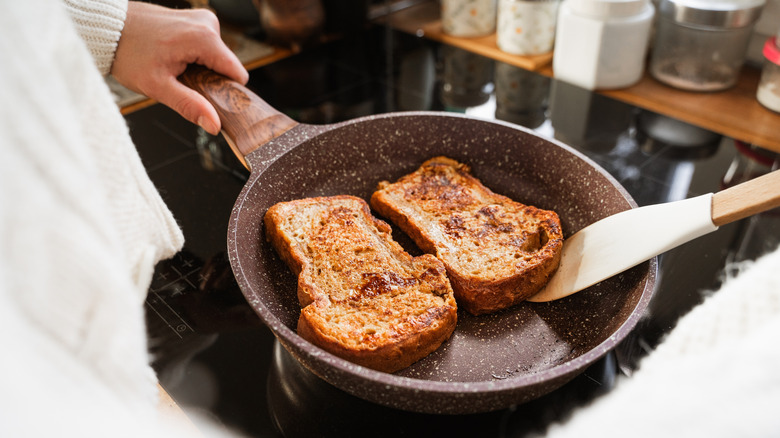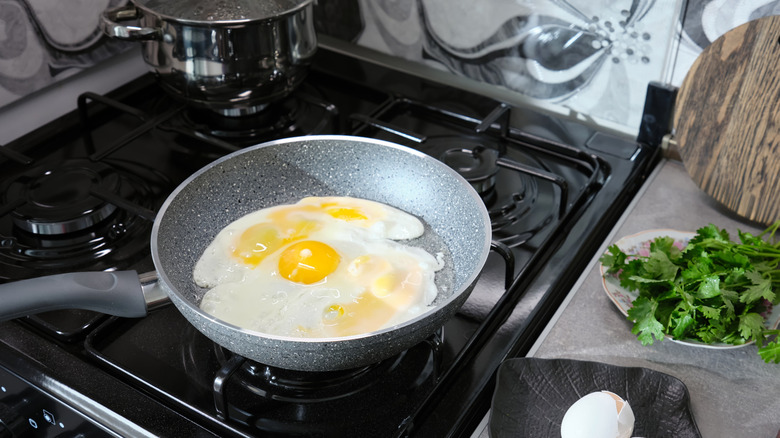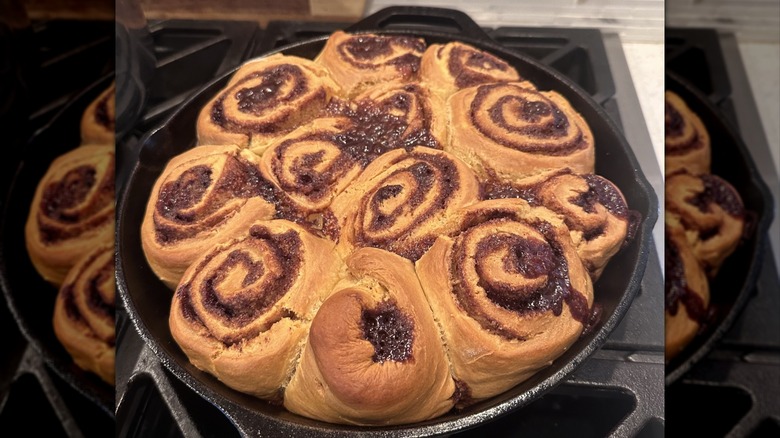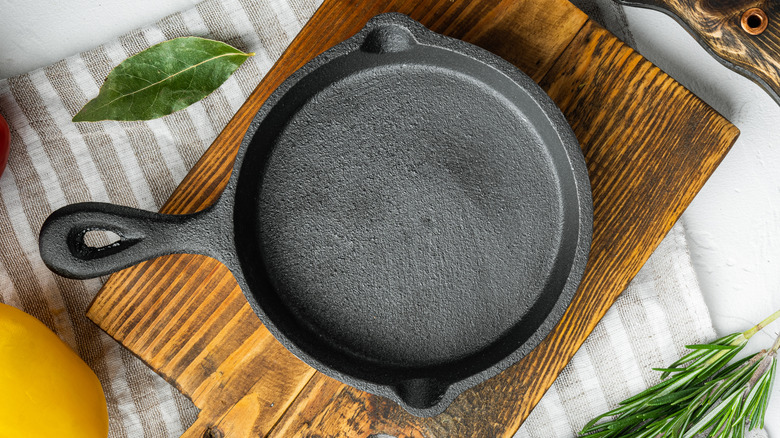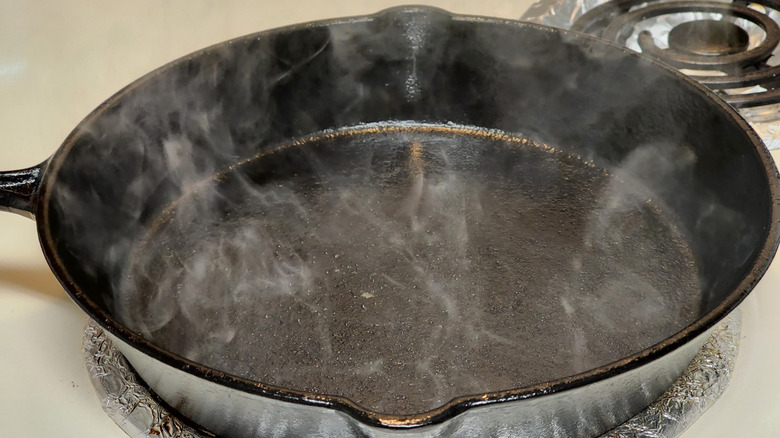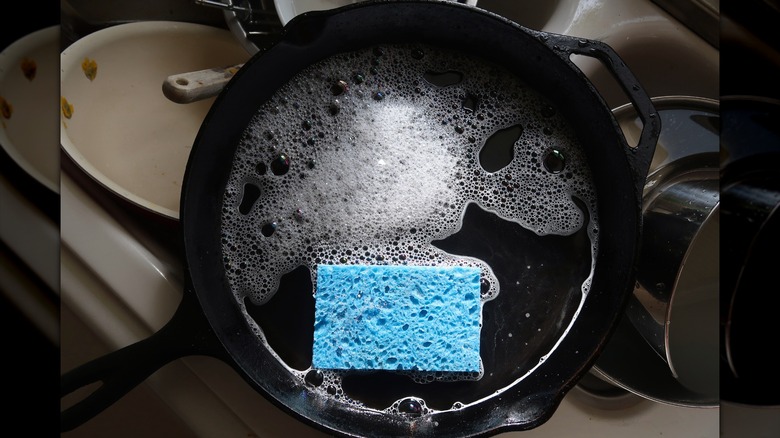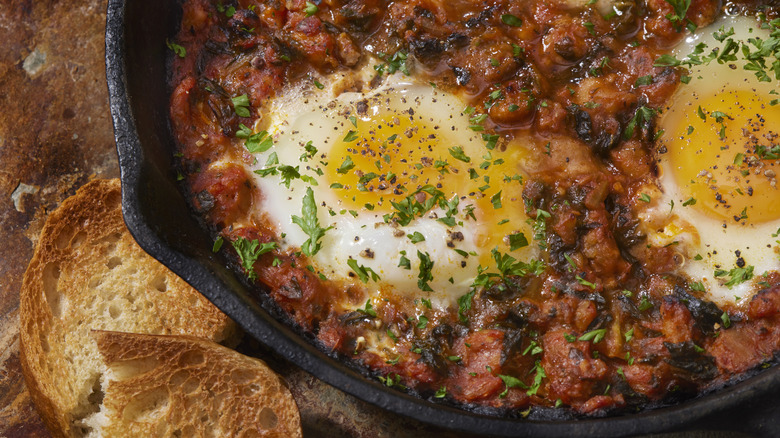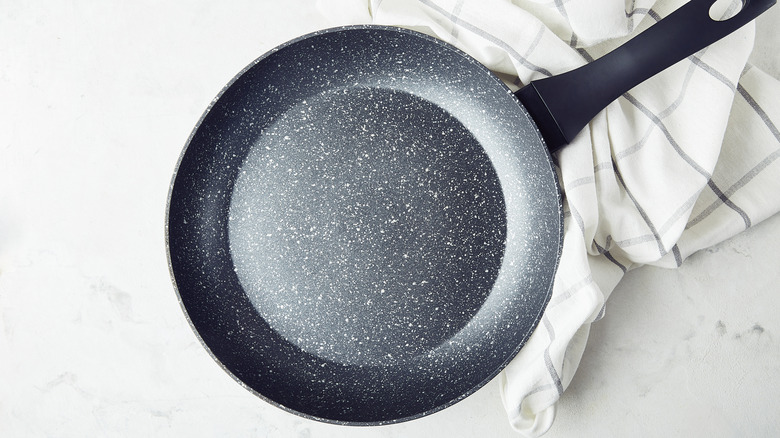Cast Iron Vs Nonstick: Which Material Is Best For Skillets?
When looking for new cookware, many folks are left with the classic conundrum of whether to buy a cast iron skillet or a nonstick skillet. Both these materials have their pros and cons, so picking the perfect one for you can be tricky. So, the best thing to do is learn about what each has to offer and their differences, which will help you make the right call.
As the name suggests, cast iron skillets are made from cast iron, a heavy duty material. Most people are talking about the uncoated type when they reference this type of skillet. However, there are some enamel-coated options that have slightly different properties and care needs. There are all kinds of myths about cast iron skillets you need to stop believing. They're more versatile than some people would lead you to believe — and they're not too much of a pain to clean or take care of, either.
Nonstick skillets are usually made from aluminum or other conductive metals and then covered with a man-made coating that prevents food from sticking to the pan. They're great for cooking certain foods but they fall down in longevity and versatility, so they're not always the best tool for the job.
We're going to go deep into cast iron versus nonstick to find out which material is best for skillets. You'll learn more about the properties of each so you can make an informed choice and avoid wasting your money.
Nonstick skillets are lighter than cast iron
When you're comparing cast iron and nonstick skillets, weight can be an important factor for some users. Nonstick skillets are significantly lighter than their cast iron counterparts, and this can make a real difference when lifting and maneuvering them. While it shouldn't be a deciding factor for the majority, people who struggle with grip or have other reasons why lifting heavy objects isn't ideal may find nonstick models easier to use.
Most 10-to-12-inch nonstick pans weigh between 2 and 5 pounds, with some lighter aluminum pans coming in under 2 pounds. On the other hand, a cast iron skillet of the same size will usually weigh around 5 to 8 pounds. There are some lighter cast iron skillets available that weigh under 3 pounds, but they're pricey and they can have some drawbacks, like not being oven-safe.
Although the heavy weight of cast iron is a drawback for maneuverability, it has its upsides. Because of the thick material, these skillets don't warp. Nonstick versions, on the other hand, are prone to warping when exposed to changing temperatures — when you run a hot skillet under a cold tap, for instance. So, what can be considered a downside of cast iron also adds to its durability and longevity. The chunky metal is part of what makes it practically indestructible. Nobody's going to be cooking with their great grandparents' nonstick pan in 100 years.
Cast iron skillets retain heat longer than nonstick skillets
Cast iron skillets retain heat longer than nonstick skillets. This is due to two simple facts: cast iron is thick and dense, and that gives it high thermal mass. In plain terms, a cast iron pan stores a lot more heat energy for its size than the thin metal bodies that underlie most nonstick pans. So once a cast iron skillet is hot, it stays hot, which matters for browning, searing, and keeping food warm at the table.
Nonstick pans, by contrast, are usually made from lightweight metals (often aluminum) with a thin nonstick coating. Those metals conduct heat quickly, so nonstick pans heat up fast, but they also lose that heat quickly because there's simply less material to hold it. If you take a nonstick skillet off the heat or add cold food, the temperature drops faster. Cast iron, on the other hand, keeps cooking even with a slight temperature change or a moment off the heat. That's why a cast iron skillet gives you better results when searing and browning ingredients.
But, because of its thick, heat-retaining material, cast iron needs longer to preheat. You should preheat it for at least three to five minutes on a burner. Nonstick needs less waiting, but you don't get anywhere near the same heat retention. So, if thermal stability and searing power matter to you, a cast iron skillet is the way to go.
Nonstick skillets heat up more quickly and evenly than cast iron
Nonstick skillets are usually built on an aluminum or hard-anodized aluminum body, and that matters a lot for how they behave on the burner. Aluminum conducts heat far better than cast iron, so nonstick pans come up to temperature quickly and respond faster when you change the heat — that's why they're so good for delicate work like eggs, crepes, or a quick sauté. Aluminum-based nonstick models heat fast and make recipes that rely on quick, even heat (like crepes or omelets) much easier to manage than cast iron.
This heat conduction also makes cooking more even — because the whole thin body of an aluminum pan is closer in temperature across its surface, you get fewer obvious cool patches away from the burner. By contrast, cast iron has much lower thermal conductivity. It takes longer to come up to temperature and can show very clear hot spots unless it's left to preheat for a long time or heated in the oven first. For recipes that need a rapid, uniform surface temperature, a nonstick pan is simply less fussy to use.
So, while cast iron retains heat well once it's hot, it takes much longer to heat up and you're more likely to get hot spots. This can lead to uneven cooking, particularly if you neglect preheating. This can make it a bit more finicky to cook with, especially when you're new to using it.
Food doesn't stick to nonstick skillets
The headline benefit of nonstick skillets — food sliding straight out of the pan — is real. PTFE (Teflon-style) coatings and many modern ceramic or proprietary nonstick finishes dramatically reduce surface friction, so over-easy eggs, pancakes, and crepes release with almost no oil and minimal scraping. Well-made nonstick pans outperform other surfaces for easy release and cleanup.
Some people talk about how their cast iron skillet has become nonstick with proper seasoning and use, but it's not the same thing. Cast iron can be reasonably nonstick for many tasks, but it won't match a modern nonstick coating for a slippery release, especially straight out of the gate with eggs or thin batters. That's why you should never cook an omelet in a cast iron pan. If your primary requirement is that nothing sticks, a nonstick skillet will save time, elbow grease, and a lot of frustration.
That said, nonstick coatings can degrade over time and with incorrect use, and once the coating is compromised, food starts to stick. Usually much worse than a well-seasoned cast iron. What's more, not every nonstick skillet performs the same. The best models release eggs and crepes smoothly, while cheaper models can perform more poorly.
The takeaway is that cast iron skillets are nonstick enough for most everyday cooking. However, when you're dealing with more delicate recipes that are prone to sticking, nonstick is the way to go. Even if you usually cook in a cast iron skillet, it can be nice to have a nonstick as a backup for certain foods.
Cast iron skillets are always oven-safe
Traditional cast iron skillets are fundamentally oven-safe. The metal itself tolerates very high temperatures, which means you can confidently start a dish on the stovetop to build color and finish it in a hot oven without worrying that the pan will warp or the body will fail. That reliability is why home cooks reach for cast iron when recipes call for moving a pan from burner to oven.
That said, "always" does come with caveats. An uncoated, cast iron skillet with a metal handle is safe at any normal oven temperature you'd use in home cooking. Enamel-coated cast iron (like many Dutch ovens and some skillets) is also oven-safe, but it does have a limited upper temperature limit of 500 to 550 degrees Fahrenheit. Then, you have to think about handles on the pans themselves and on lids. If they're made of plastic or wood (which is rare but not unheard of), check the instructions to determine whether or not you can put them in the oven.
But with nonstick skillets, oven compatibility depends on the coating, as well as the handle construction. Some modern nonstick pans are advertised as oven-safe to a certain temperature (often in the 350 to 500 degrees Fahrenheit range), but those limits vary by model and manufacturer. Beyond those temperatures the coating can degrade or release fumes, and some handles or rivets may be damaged. This kind of temperature damage to the coating might be the reason your nonstick pan sticks. So, if you want to go from stovetop to oven, opt for cast iron.
Cast iron is more durable than nonstick
Durability is where cast iron really stands out. A well-made cast iron skillet is essentially indestructible in everyday home use. There's no coating to scratch, it won't delaminate, and it will last through decades of regular use with only routine care. Clean it gently, dry it thoroughly, and reseason it when needed and you'll have cookware that truly lasts a lifetime.
Nonstick pans, by contrast, have a natural expiration date tied to their surface. The PTFE or ceramic-like coatings that make them wonderfully easy to cook with are relatively thin and vulnerable to abrasion, overheating, and rough handling. Nonstick surfaces gradually degrade: metal utensils, abrasive scrubbers, stacking without protection, and even repeated high-heat use will shorten the effective life of a nonstick pan. Because of that, a nonstick pan usually needs replacement within three to five years — how quickly depends on care and quality, but the consensus is it doesn't last forever.
That doesn't mean nonstick is bad, it's just different. For people who value convenience, the lack of durability can be a worthwhile trade-off for the ease of use and cleaning. Avoiding using metal utensils and caring for it properly will make it last longer. But if you want true durability and a piece of cookware that could be around for hundreds of years, cast iron is what you should be investing in.
Cast iron skillets generally require seasoning
Nonstick skillets are ready to go straight off the shelf, but bare cast iron pans need to be seasoned. Seasoning has nothing to do with salt and pepper. It means building a polymerized layer of oil on the metal by applying a thin coat of fat and heating it until it bonds to the iron. That layer fills microscopic pores, helps food release, and protects the skillet from rust.
If you're wondering how to season a cast iron skillet, there are plenty of guides that will walk you through basic seasoning steps. There are various methods, but all involve rubbing a neutral oil thinly over the surface, and baking or heating to polymerize. When complete, you're left with a surface that becomes more and more nonstick with repeated use. Seasoning does need occasional attention but it's not high maintenance. For everyday use, cooking with oil, avoiding long soaks, and rubbing on a little extra oil after cleaning and drying your skillet is usually enough to keep the seasoning happy.
It's worth noting that enameled cast iron doesn't need this seasoning routine because the enamel provides a protective, nonreactive surface. You lose some of the "built-up" nonstick quality that bare, well-seasoned iron develops, but you gain an easier-cleaning, rustproof pan. You might also notice that many cast iron pans come preseasoned, which saves some time, but adding an extra layer or two of seasoning still gives you better results.
Nonstick skillets are easier to clean
If you're looking for a skillet that's always a breeze to clean, nonstick is the way to go. Because the cooking surface is covered with a slick polymer or ceramic layer, foods that normally cling just slide right out with only a quick rinse and a soft sponge. Unless something goes horribly wrong in the kitchen, you're not going to be left with a burned on mess that needs loads of scrubbing to come clean.
However, nonstick coatings are delicate by design, so you shouldn't use abrasive scrubbers or steel wool. Most manufacturers recommend washing by hand with warm soapy water and a soft cloth or sponge. If your pan is labelled dishwasher-safe, you can use the machine occasionally, but repeated dishwasher cycles will shorten the coating's useful life.
Cast iron skillets aren't quite as easy to clean, but they're not as tricky to care for as some people say they are. For instance, it's a myth that you must never use soap on cast iron — a little mild dish soap won't destroy a well-seasoned pan. It's a tough, polymerized coating on the surface, not just a layer of oil that will come off with some soap. Scrubbing it to remove stuck on food is also fine, just avoid long soaks, cleaning it in the dishwasher, or going at it heavily with steel wool. Usually, if you want to remove the coating and start again, you have to burn it off at extreme temperatures, so a little soap and a scrubbing brush won't do any harm.
Cast iron skillets can increase the iron content of your food
One surprising advantage of cooking in bare cast iron is that it can leach small amounts of dietary iron into food. In many cases, that's a useful bonus. The surface of an unenameled cast iron pan will transfer trace iron to whatever you're cooking, especially when the dish is acidic (such as tomato-based sauces) and cooked for a longer time. Because the amounts are generally modest, cast iron shouldn't be relied on as your primary iron supplement, but every little bit helps if you're iron-deficient.
Because your food doesn't touch the metal surface, enameled cast iron pans don't have the same benefit. And, because nonstick pans aren't made from iron, nor is there iron in the coating, they won't increase the mineral content in your food. If you have a medical condition like hemochromatosis (where the body stores too much iron), extra iron from cookware is something to avoid — in that case, nonstick or enameled cookware is safer. Otherwise, it might be a nice bonus to have a little extra iron in your meals.
Nonstick skillets have chemical coatings
Nonstick skillets owe their slickness to engineered surface layers — traditionally PTFE (commonly known by the brand name Teflon) and more recently a range of ceramic or hybrid coatings. Those finishes are what make flipping eggs and sliding pancakes effortless, but they often contain man-made chemicals, unlike cast iron skillets.
Most nonstick coatings perform best at low-to-medium heat. Sustained high heat can degrade the coating, shorten its life, and release unpleasant fumes. That's why you shouldn't use high heat with nonstick pans. Particularly when they're heated empty, they can release chemicals that can potentially make you sick.
Older, more toxic compounds used in nonstick pans have since been phased out in many countries. Modern, reputable nonstick pans are made without the worst ingredients. But, even newer nonstick coatings come with potential health risks. Though there's no hard proof, some studies suggest a correlation between chemicals used in nonstick pans and some types of cancer. There's not enough evidence to totally ditch nonstick, but it's better not to cook absolutely everything in these types of pans. Reduce the amount you use them — particularly for high-heat cooking — and you'll minimize your exposure.
